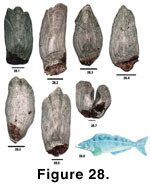 Description
DescriptionOphiodon elongatus (Lincod)
(Other common names: Buffalo Cod; Blue Cod; Pacific Cultus)
Figure 28.8
 Description
DescriptionLength: 152 cm; females larger than males.
Mouth: large with gape, terminal, directed upwards; maxillary extend beyond the posterior edge of the orbit; lower jaw projects; teeth large and canine.
Body: long notched (separates soft-rayed and spinous portions) single dorsal fin; single anal fin with three spines; caudal fin truncate; thoracic pelvic fins; four to five preopercule spines; one lateral line; multifidus circus over each eye.
Colour: dark green to bluish to mottled brown; pale below; light spots.
Depth: 475 m; seasonal migration between shallow and deep waters.
Habitat: juveniles in sandy or mud bays; adults in rocky reefs and kelp; both migratory and non-migratory populations.
Season: spawns winter to early spring.
Diet: the diet of the juveniles may consist of copepods, shrimp, and other crustaceans. The adults feed upon herring, flounders, cod, whiting, squid, and juvenile lingcod.
Predators: not determined.
Distribution: southern California to Alaska.
 Scale
Description
Scale
DescriptionScale Type: cycloid.
Relative Scale Size: small to moderate.
Position of Scales on Body: covers body and head (Hart, 1973).
Overall Shape: elongate to oval.
Focus and Circuli: the focus is centralized between the four fields. The posterior field is speckled with protruberances. The circuli are continuous between the anterior and lateral fields.
Radii: numbers are variable and not diagnostic. Present in the anterior field only. The outer edge of the anterior field is convex and distinctly scalloped.